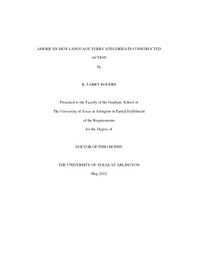
ATTENTION: The works hosted here are being migrated to a new repository that will consolidate resources, improve discoverability, and better show UTA's research impact on the global community. We will update authors as the migration progresses. Please see MavMatrix for more information.
Show simple item record
| dc.contributor.author | Rogers, K. Larry | en_US |
| dc.date.accessioned | 2012-07-25T19:10:26Z | |
| dc.date.available | 2012-07-25T19:10:26Z | |
| dc.date.issued | 2012-07-25 | |
| dc.date.submitted | January 2011 | en_US |
| dc.identifier.other | DISS-11345 | en_US |
| dc.identifier.uri | http://hdl.handle.net/10106/11124 | |
| dc.description.abstract | The American Sign Language construction commonly known as "role-shift" superficially resembles mimic forms, however unlike mime, role-shift is a type of depicting construction in ASL discourse (Roy 1989). The signer may use eye gaze, head shift, facial expression, stylistic variation, and use of signing space to convey information (Lee 1997). While this construction may involve a level of gesture, it is linguistic in nature (Padden 1990). "Role-shift may be used to recreate the action in a narrative, thus the term: constructed action” (Metzger 1995). This aspect to depict action is the particular focus of this study. Participants were videotaped telling one of two narratives in order to analyze these instantiations of the CA framework. Specifically, this study looks at the verb types used in CA. The study then questions the interrelational function(s) between CA and verb types and posits possible explanations for their patterns. The study concludes with a positive correlation for a specific verb used in ASL constructed action and that a cognitive iconicity principle may license the use of constructed action. | en_US |
| dc.description.sponsorship | Stvan, Laurel Smith | en_US |
| dc.language.iso | en | en_US |
| dc.publisher | Linguistics | en_US |
| dc.title | American Sign Language Verb Categories In Constructed Action | en_US |
| dc.type | Ph.D. | en_US |
| dc.contributor.committeeChair | Stvan, Laurel Smith | en_US |
| dc.degree.department | Linguistics | en_US |
| dc.degree.discipline | Linguistics | en_US |
| dc.degree.grantor | University of Texas at Arlington | en_US |
| dc.degree.level | doctoral | en_US |
| dc.degree.name | Ph.D. | en_US |
Files in this item
- Name:
- Rogers_uta_2502D_11345.pdf
- Size:
- 3.256Mb
- Format:
- PDF
This item appears in the following Collection(s)
Show simple item record


